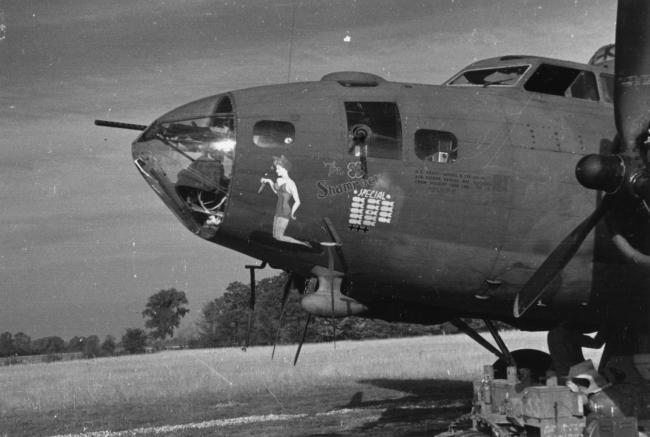Alconbury
Airfield
IWM, English Heritage Collection
Object Number - US_7GR_LOC334_V_5021 - Aerial photograph of Alconbury airfield, looking east. The technical site is at the top, the bomb dump is on the left, 9 May 1944. Photograph taken...
Alconbury had been constructed as a satellite airfield for RAF Upwood and Wyton and was used by RAF Squadrons: Nos. 15, 40 and 156. In preparation for the arrival of American heavy bombers, the base was developed in 1942 with the runways extended. When these extensions were finished the total area of land occupied by the base was 500 acres. Alconbury was the first Eighth Air Force base to be visited by King George VI, who visited the 93rd Bomb Group based there on 13 November 1942. In May 1943, while the 95th Bomb Group were stationed there, a fatal accident occurred. A 500lb bomb inexplicably went off whilst a B-17 was being loaded. It set off several others. Eighteen men were killed, twenty-seven injured and four B-17s completely destroyed. In the late summer of 1943 the 92nd Bomb Group left to make way for specialist Pathfinder Groups. It was announced in January 2015 by the US Department of Defense that RAF Alconbury will close as a USAFE base in 2022. The USAF intelligence and support elements currently located at RAF Alconbury and RAF Molesworth will be combined in a new complex at RAF Croughton, Northamptonshire. RAF Mildenhall, Suffolk, will also close as a USAFE base after 2020.
Connections
See how this entry relates to other items in the archive by exploring the connections below.
English Heritage's Record Description
A military airfield built in 1938 as a satellite airfield for Royal Air Force Wyton. The airfield initially had 3 runways. Until 1942, it was the base for 15, 40 and 156 Squadrons of the Royal Air Force. In 1942 the airfield was expanded to a 500 acre site, the length of the runways was increased and 26 hardstanding loops were added. In 1943 a Strategic Air Depot was built on the east side of the site in the village of Little Stukely. From 1942 onwards the site was used by the 8th United States Army Air Force. The 93rd bomber group flying Liberators were the first American Unit at the base, from September to December 1942; they were followed by the 92nd Bombardment Group, nicknamed "Fame's Famous Few", operating Flying Fortresses. For a short time between April and June of 1943 they were joined by 95th Bomber Group. On May 27th 1943, as aircraft were being armed there was an accidental detonation of some of the 500 pound bombs, which killed and injured a number of men and destroyed or damaged 15 aircraft. In September 1943 the 92nd moved out to be replaced by 482 Bombardment Group's pathfinders, operating B-17 Flying Fortresses and Liberators. From March 1944 they concentrated on testing and training with radar devices. The depot to the east side of the site was run as a seperate station by 2nd Strategic Air Depot. From November 1945 to 1948 the site was also used by the Royal Air Force 264 Munitions Unit. After World War Two the base continued to be used by the United States Air Force (Europe). The base was upgraded and modernised in 1951. In 1982 until the late 1980s the base was used by the 19th Reconnaissance Squadron. Special extra-wide hardened aircraft shelters were constructed to accommodate their large TR1 aircraft; in the late 1980s a 2-storey bunker was built as a centre for evaluating intelligence. The base closed in 1995. Some buildings survived in 2003, the site is said to be designated as a brown field site for housing or a distribution centre.
People
![Staff Sergeant Donald W. Crossley, a tail gunner of the 95th Bomb Group in position inside a B-17 Flying Fortress. Image stamped on reverse: 'Associated Press.' [stamp] Handwritten caption on reverse: '21/9/43.' A printed caption was previously attached to the reverse of print, this has been lost, however considering the publication date, press agency and subject matter this was likely to have read: 'AWARDS TO THE HIGH-SCORING GUNNER. The Distinguished Flying Cross and an oak leaf cluster- the equivalent](https://assets.americanairmuseum.com/s3fs-public/styles/max_650x650/public/freeman/media-379270.jpg?itok=Sb9H90E6)
- Military/Civilian/Mascot: Military
- Nationality: American
- Unit: 95th Bomb Group 334th Bomb Squadron
- Service Numbers: 15107390
- Highest Rank: Technician Third Grade
- Role/Job: Tail Gunner

- Military/Civilian/Mascot: Military
- Nationality: American
- Unit: 92nd Bomb Group 327th Bomb Squadron
- Service Numbers: 39393756
- Highest Rank: Staff Sergeant
- Role/Job: Tail Gunner
- Military/Civilian/Mascot: Military
- Nationality: American
- Unit: 92nd Bomb Group 326th Bomb Squadron
- Service Numbers: 38069037
- Highest Rank: Staff Sergeant
- Role/Job: Top Turret Gunner
- Military/Civilian/Mascot: Military
- Nationality: American
- Unit: 482nd Bomb Group 813th Bomb Squadron
- Highest Rank: Captain
- Role/Job: Navigator

- Military/Civilian/Mascot: Military
- Nationality: American
- Unit: 92nd Bomb Group 327th Bomb Squadron
- Service Numbers: 36044419 / O-793749
- Highest Rank: Captain
- Role/Job: Pilot
Aircraft
- Aircraft Type: B-17 Flying Fortress
- Unit: 92nd Bomb Group

- Aircraft Type: B-17 Flying Fortress
- Aircraft Type: B-17 Flying Fortress
- Aircraft Type: B-17 Flying Fortress
- Nicknames: The iron maiden
- Unit: 379th Bomb Group 92nd Bomb Group 407th Bomb Squadron 525th Bomb Squadron

- Aircraft Type: B-17 Flying Fortress
- Nicknames: The Shamrock Special
- Unit: VIII Air Force Service Command 91st Bomb Group 95th Bomb Group 335th Bomb Squadron 336th Bomb Squadron 401st Bomb Squadron
Revisions
Connected aircraft records that have 'Alconbury' in their biography fields.
Dates of American use added. Source: From Far Afield They Came... by Margaret Winham
USAFE-AFAfrica Press Release, 08 January 2015. See http://www.mildenhall.af.mil/news/story.asp?id=123435803.
Barry Anderson, Army Air Forces Stations (Alabama, 1985) / Roger Freeman, Airfields of the Eighth Then And Now (London, 1978).











